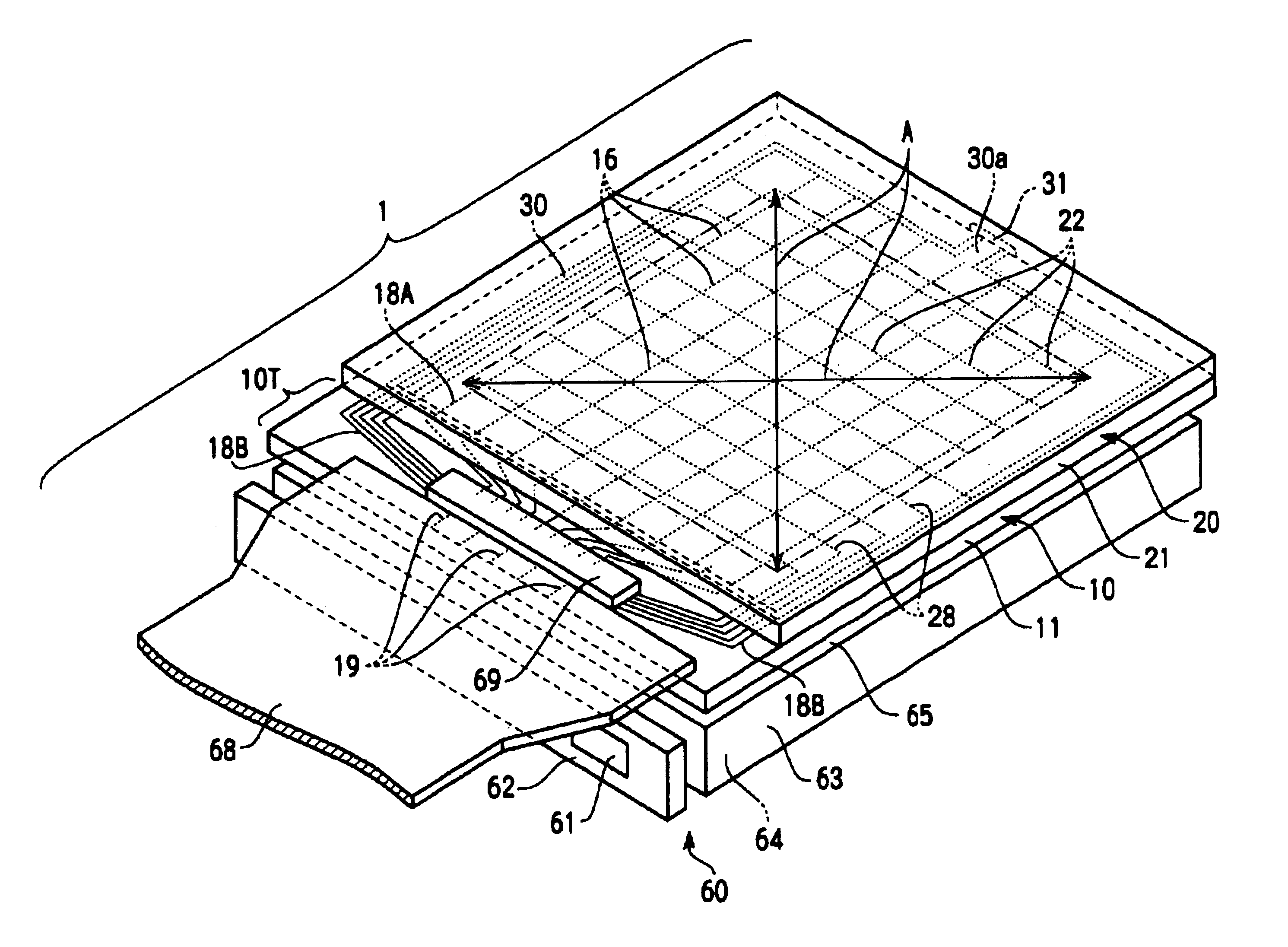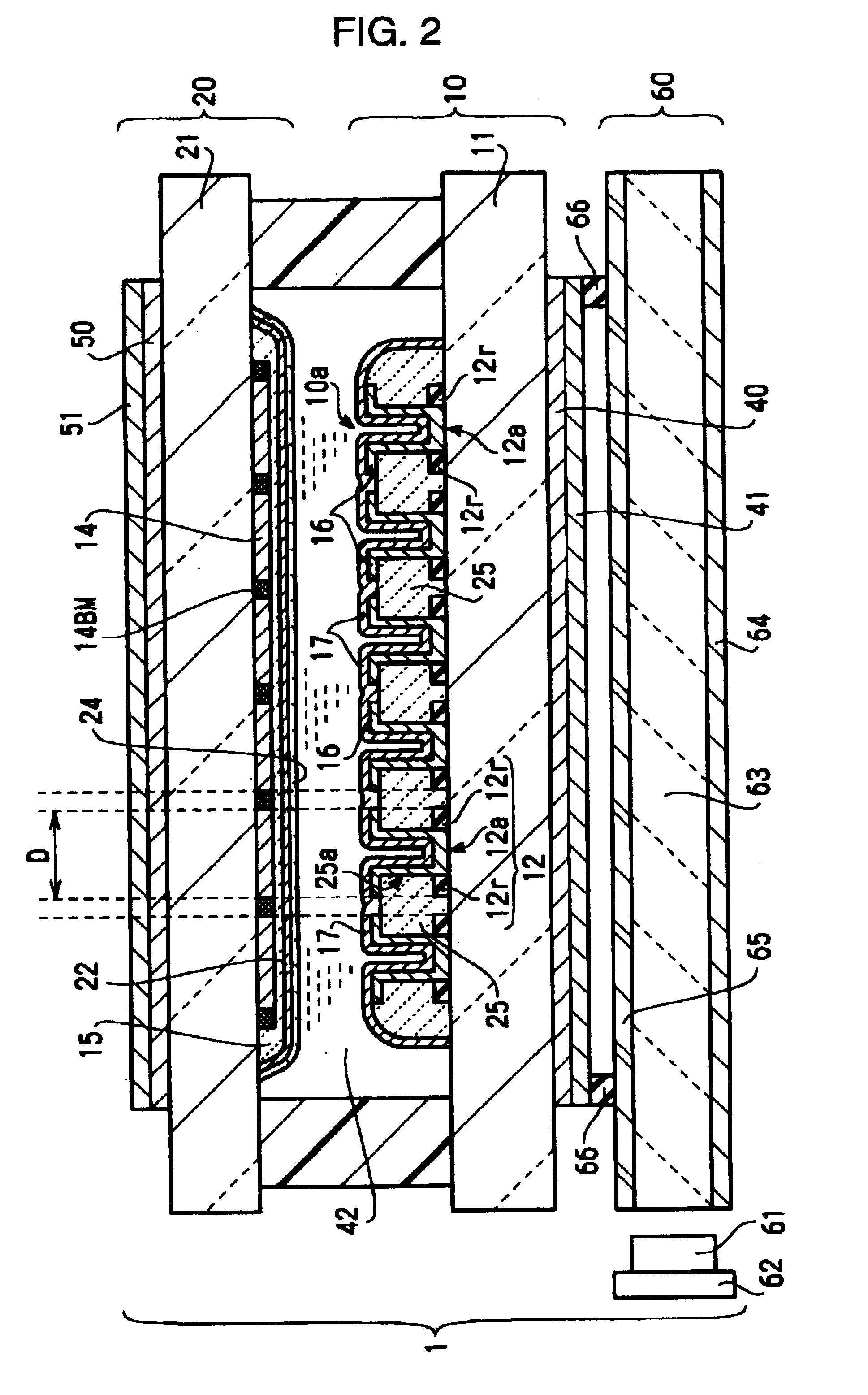Substrate for electrooptic device and method of manufacturing the same, electrooptic device, and electronic equipment
a technology of electrooptic devices and substrates, applied in the direction of optics, identification means, instruments, etc., can solve the problems of inability to achieve sufficient brightness, and low so as to shorten the manufacturing process, reduce the brightness of an image display, and increase the utilization efficiency of transmitted light
- Summary
- Abstract
- Description
- Claims
- Application Information
AI Technical Summary
Benefits of technology
Problems solved by technology
Method used
Image
Examples
first embodiment
[0060
[0061]First, a liquid crystal device which is one embodiment of the electrooptic device of the present invention will be described with reference to FIGS. 1 through 4. FIG. 1 shows the external appearance structure of the liquid crystal device in this embodiment. FIG. 2 shows the sectional structure of the liquid crystal device. FIG. 3 shows several display dot parts in a substrate for the liquid crystal device as constitutes this liquid crystal device, in plane and on an enlarged scale. FIG. 4 shows portions in FIG. 2 on an enlarged scale. Incidentally, a liquid crystal device 1 shown here is one of passive matrix scheme of so-called “semitransmissive reflection type”.
[0062]As shown in FIG. 1, the liquid crystal device 1 includes a substrate for the liquid crystal device 10, whose basic body is a first base member 11 made of a glass plate, a synthetic resin plate or the like and being transparent or having light transmissivity, and an opposing substrate 20 whose basic body is ...
second embodiment
[0102
[0103]Next, a liquid crystal device which is another embodiment of the electrooptic device according to the present invention will be described with reference to FIGS. 6 through 8. FIG. 6 shows the sectional structure of the principal portions of the liquid crystal device 101. FIG. 7 is a plan view in which a substrate for the liquid crystal device as constitutes the liquid crystal device 101 is seen in the plus direction of a Z-axis in FIG. 6. FIG. 8 is a plan view in which an opposing substrate constituting the liquid crystal device 101 is seen in the plus direction of the Z-axis in FIG. 6. Incidentally, FIG. 6 is a sectional view taken along line X1-X1′ in FIG. 7 and line X2-X2′ in FIG. 8.
[0104]The liquid crystal device 101 is a liquid crystal device of active matrix scheme employing TFD (Thin Film Diode) elements as active elements. Referring to FIG. 6, the opposing substrate 120 is provided with each transparent electrode 122 which is arranged so as to coincide with a corr...
third embodiment
[0117
[0118]Next, a liquid crystal device which is another embodiment of the electrooptic device according to the present invention will be described with reference to FIGS. 9 and 10. FIG. 9 shows the sectional structure of the principal portions of the liquid crystal device 201. FIG. 10 shows a plane structure in the case where an opposing substrate 220 constituting the liquid crystal device 201 is seen in the minus direction of a Z-axis in FIG. 9. The opposing substrate 220 is sometimes called the “color filter array substrate”. Incidentally, FIG. 9 is a sectional view taken along line X3-X3′ in FIG. 10. This embodiment is the liquid crystal device of active matrix scheme in which TFT (Thin Film Transistor) elements 230 being active elements of 3-terminal type are employed as the active elements.
[0119]Referring to FIG. 9, the opposing substrate 220 is the color filter array substrate provided with each transparent electrode 222 which is arranged so as to coincide with a correspondi...
PUM
| Property | Measurement | Unit |
|---|---|---|
| transmission factor | aaaaa | aaaaa |
| refractive index | aaaaa | aaaaa |
| thickness | aaaaa | aaaaa |
Abstract
Description
Claims
Application Information
 Login to View More
Login to View More - R&D
- Intellectual Property
- Life Sciences
- Materials
- Tech Scout
- Unparalleled Data Quality
- Higher Quality Content
- 60% Fewer Hallucinations
Browse by: Latest US Patents, China's latest patents, Technical Efficacy Thesaurus, Application Domain, Technology Topic, Popular Technical Reports.
© 2025 PatSnap. All rights reserved.Legal|Privacy policy|Modern Slavery Act Transparency Statement|Sitemap|About US| Contact US: help@patsnap.com



